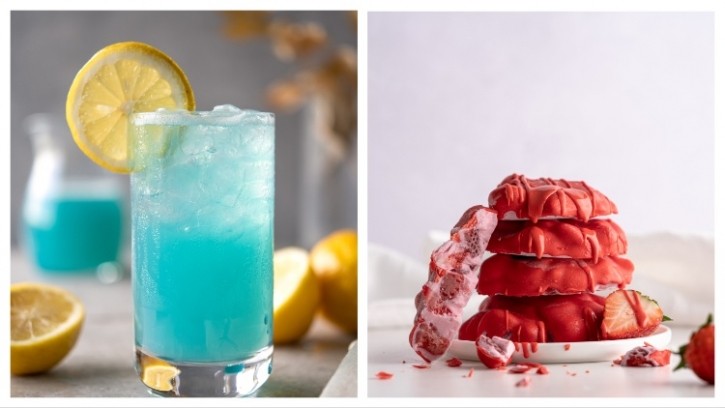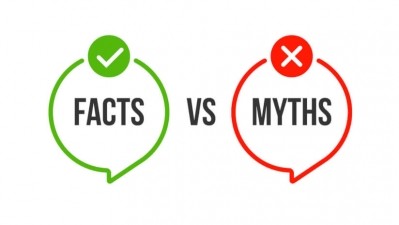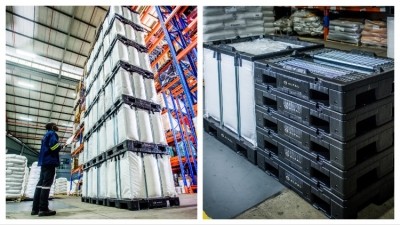Feature
Is the UPF debate impacting colour?

Clean label ingredients saw steady growth between 2018 and 2022, with health-geared buys winning favour during the pandemic.
The next several years will likely see products associated with health (both one’s own and the planet’s) and short, ‘clean’ labels continue to grow in popularity, as this movement gains further momentum off the back of ultra-processed food concerns.
Research from FMCG Gurus, highlighted in its Top Ten Trends for 2024 report, found that as many as 73% of global consumers are seeking food and drink products that contain recognisable ingredients. Moreover, the same number are said to find ‘natural’ products appealing, with 74% of consumers claiming they check ingredient lists.
Food colours: What consumers want to see
Among the considerations for any ingredients list is colour – often one of the first things consumers notice even without looking at the back of pack – which has, historically, been created artificially.
In fact, Future Market Insights research predicts that demand for plant-based colours, globally, will be worth around $15.8bn by 2032, growing by a CAGR of 5.3% (since 2022) with Europe primed to dominate the market.
Emina Goodman, senior commercial director of colour development at ADM, agrees that colour is a key factor for consideration, as consumers seek-out familiar ingredients that are “closer to nature”.
ADM has responded accordingly with a full rainbow of what it’s branded ‘Colors from Nature’, with solutions that stretch across food, drink, dietary supplements and even pet food.
Speaking with her on the topic, she offered further weight to this trend, as she cited FMCG 2023 Gurus’ Flavors, Colors & Textures in EMEA research: “73% of consumers throughout Europe, the Middle East and Africa agree it’s important that food and drink products do not contain artificial colours or chemically produced colours.”
Emma Leys, marketing communications specialist for GNT UK, which also offers a full spectrum of colouring foods made from edible fruits, vegetables and plants, agreed there’s been a big move towards ‘label readers’.
“It’s certainly the case that shoppers are reading the labels more closely now and looking out for natural ingredients. In some cases, they’re just looking to avoid certain ingredients like artificial colours or carmine. Others want to see completely clean labels with ingredients they know and trust,” Leys explained.
“The growing discussion around ultra-processed products is clearly going to increase scrutiny on ingredient lists, so it’s more important than ever to use colours that give consumers a sense of reassurance."

Although certain scientific descriptors might not be common in the average consumer’s lexicon, natural colours generally support simple label declarations such as ‘free-from artificial colours’ and ‘made with carrot concentrate’, for example. These can offer reassurance in the case where ingredient names aren’t so recognisable.
While some keen-eyed consumers will be more than happy to flip packs, the use of natural colouring also creates opportunities to highlight their inclusion and create brand stories not just on pack, but online too.
“Manufacturers can share positive messages about how the raw materials are grown and processed, using text and images to showcase their naturality. That creates a talking point as well as a selling point, helping to create positive associations with your brand,” suggested Leys.
Combatting chemophobia
In a not too dissimilar vein, fellow ingredients company Givaudan, which has a portfolio boasting its simple label ‘Naturbrown’ ingredients and ‘Vegebrite’ colouring foodstuffs, has been working on its own storytelling project. This is focused on educating customers and consumers alike on colours and to quell any unreasonable fears around chemical-sounding names.
“We have established outreach channels and tools designed to inform and educate about our colours, their sources and how they are obtained and formulated. These tools help to discourage misinformation and chemophobia by showing that biology and nature also speak the language of chemistry because, ultimately, all living forms are made out of molecules,” said Catalina Ospina, technical marketing specialist for Givaudan Sense Colour.
So…what makes a colour ‘natural’?
There is no universally agreed definition of what makes a colour natural, with the letter of the law depending on where you are in the world.
However, Ospina told Food Manufacture that generally speaking ‘natural colour’ is “accepted to mean pigments that are derived from natural sources like vegetables, fruits, minerals, spices, algae, fungi, and other edible sources that are used to impart colour and visual appeal in foods and beverages”.
She continued: “These pigments are subjected to varying degrees of processing, such as extraction, purification, stabilisation, and formulation. We are members of NATCOL, the Natural Food Colors Association, and embrace their definition and range of classification categories that include ‘natural origin’, ‘nature derived’, ‘non-artificial’, and ‘nature identical’.”
“Consumers will all have their own ideas about what they consider to be truly natural,” added Leys. “Under EU and UK regulations, natural colours can come from a range of sources including fruit, vegetables, spices, algae, grass and – in the case of carmine, the cochineal insect. Colouring foods are classed separately and need to come from edible fruits, vegetables and plants and be processed without the selective extraction of pigments.”
It is also worth noting that in the EU and UK, food additives (including colours) need to undergo an authorisation procedure before being used in food products.
As the experts at Campden BRI explained: “Any substance that falls under the definition of a food additive and specifically in this circumstance the definition of ‘colours’, as defined in the legislation, must therefore be authorised for use as a food additive in the product category of the food to which you intend to add it.
“Any ingredient/substance promoted as a ‘natural’ alternative to a food additive would still be in scope of the legislation if it falls under the definition of a food additive set out in the legislation and does not meet any of the exemptions listed in the legislation. It is therefore important to keep in mind this definition when discussing any alternative options with your suppliers.”
The complications of nature
While natural colours certainly came before manmade versions, artificial colourings ruled the roost for a time, with their ‘one size fits all’ reputation. This is likely a result of the complexities natural colourings once presented – and whilst there are still some creases to be ironed out, innovations in this space have really helped to accelerate their application.
Offering further context, Leys said: “Plant-based colours are based on the natural pigmentation from the raw materials. Because of that, all colours and raw materials have their own properties and optimal performance conditions. That means you need to understand the technical characteristics of the colours you’re using as well as the customer’s application and process. For some raw materials, the pH of the base product might lead to a colour shift.
“You also need to know what other ingredients the product contains that might influence stability. It might contain antioxidants or minerals that have an impact on the performance of certain colours – sometimes that will be positive and sometimes it will be negative. You need to understand this as well as the process that the finished product will go through. Is it pasteurized? Is it baked? Is it fried? Is it going to be reconstituted by the consumer? Is it going to be in transparent packaging? Is it going to be in opaque packaging? Is the shelf-life a year, three months or 14 days? All these things come into play.
“In the early days of GNT, these factors really restricted the possibilities for plant-based colours. Since then, we’ve not only expanded our range of colours to cover the full rainbow but also the range of raw materials and our technical understanding.”

Ospina agreed, emphasising that “formulating for performance” and “selection of the right colouring solution” are key to achieving desired outcomes.
“Deodorising, stabilising, emulsifying, screening for improved agricultural or biotechnological varieties and working with synergistic antioxidant systems are a few of the strategies that are used to achieve stable and vibrant natural colours in all sorts of food and beverage applications,” the Givaudan technical marketing specialist said.
“For example, we just released our Endure red beet, which is a red beet that has been stabilised to perform better in bakery compared to a standard beet product. This gives developers a kosher and vegan option for red velvet cakes that also doesn’t have use rate limitations like carmine. And we’re always exploring new potential sources and manufacturing methods that can provide improved stability over current options.”
The use of heat has proven especially troublesome in the past when it comes to colour stability, so there has been an increasing interest in enhanced methods of stabilising and ‘gentler’ shelf-life extension. Certain natural colours are particularly thermal sensitive, including green and blue.
“There are ways to overcome that, such as overdosing your colour to compensate for colour loss during heating, but it needs to be approached carefully,” offered Leys. “Beverages were a longstanding issue for natural blues, but we’ve now developed a patented technology that helps to stabilise the spirulina so that it remains clear and blue in applications including sports, energy and carbonated drinks.”
Pulsed electric field processing is an example of an alternative technology to thermal processing
According to Campden BRI, this tech “delivers a gentler decontamination/pasteurisation process, which can therefore offer advantages such as improved colour retention”.
The Campden team continued: “PEF technology applies high electric voltage pulses to products to cause electroporation in cells. Lower electric field strengths can be used for inducing holes in larger cells like vegetable or meat cells (e.g. for extraction or improved drying). Higher electric field strengths are required for perforating small cells like microorganisms (for using PEF to decontaminate and pasteurise products).
“Another processing example is high pressure processing (HPP), which is now a well-established process for pasteurisation, can inactivate vegetative microorganisms, and is sometimes used to bring about desirable changes to food.”
According to Campden BRI, for many products – such as ready-to-eat vegetable meals, guacamole, dry-cured products and fruit juices – HPP enables pathogen control and shelf-life extension, without preservatives and with minimal impact on sensory properties such as colour.
Stability is also an area ADM has been focused on, alongside ensuring flavour isn’t impacting by the colours sourced from nature (fruits, veggies, botanicals etc).
“Patented and proprietary technologies ensure all our Colors from Nature retain brilliance, stability and consistency throughout potential challenges of formulation, transit and shelf life. For example, our patented emulsion system develops heat-, light- and acid-stable colours to prevent staining, ringing, bleeding of colour, precipitation, sedimentation and interaction with other ingredients in food and beverage systems,” shared Goodman.
“Our emulsion technology also improves overall taste and texture, delivers various opacity levels, mitigates potential staining in food and beverage packaging and offers wide regulatory acceptance.”
ADM also deploys advanced micronised technology, which supports critical plating characteristics for additional stability within colour solutions derived from natural sources.
“Deodorising, masking and extraction technologies help eliminate any off notes. Our extraction technology also removes sugars, starches and proteins, helping colours derived from botanical and plant extracts withstand tough formulation environments,” added Goodman.
But even ‘tougher’ natural pigments like beta-carotene, copper chlorophyllin and annatto extracts have their pitfalls and opportunities for further expansion – a focus Givaudan has been working on.
Ospina used the latter two as examples: “These colours have excellent stability to heat and light exposure but are not as stable in low pH systems. To expand their use in applications like acidified dairy or even beverages, we’ve formulated versions that are protected against acid.”
The future of food and drink colours
She added, thoughtfully: “We no longer think of natural colours in terms of their possible innate limitations but of the multitude of possibilities that formulation and a deeper knowledge of their chemical interactions can offer to a performance-oriented colour solution.”
A lot of progress has been made by food businesses in the clean label domain since the spotlight first hit it, whether that’s devising natural ways to sweeten, preserve or, indeed, colour food and drink.
While natural ingredients can be used to this end regardless of the level of processing involved, the experts agree that the attention on ultra-processed food has reinvigorated consumer’s hungriness for clean labels, while turbocharging scrutiny.
This will certainly serve up new challenges (and opportunities!) in the future, as innovators attempt to meet with the (sometimes conflicting) demands of consumers, as well as balancing cost, availability, shelf-life and taste.
Liked this? Then you'll love our Q&A with ADM's development chef, Philipp Weiler.

















